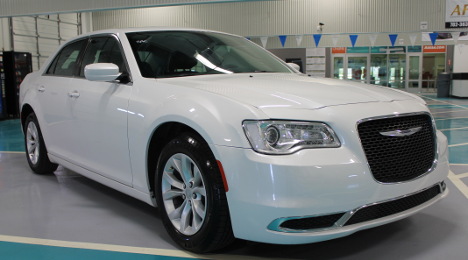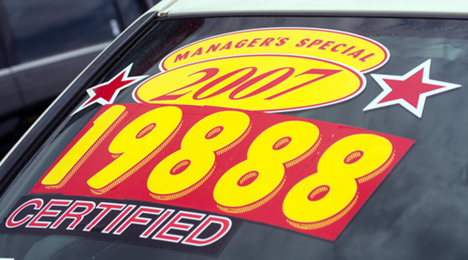Larry H. Miller Dealerships just welcomed three new stores into the family.
LHM Dealerships on Tuesday announced the acquisition of three stores in Colorado, with the purchase of Cherry Creek Dodge in Denver, Fiat of Denver and Colorado Chrysler Jeep in Aurora. The dealership group owns 11 stores in Colorado after this move.
“We’ve been strategic in our approach to growth and in finding opportunities that are a win-win for the seller, employees and our company. Denver is a strong market for us and these brands are a great fit with our business model,” Dean Fitzpatrick, president of Larry H. Miller Dealerships, said in a news release. “With the acquisition of these dealerships, we are able to employ more Denver residents and deepen our connection and commitment to the community.”
LHM Dealerships, which operates 58 stores in seven states, said that it will retain all current employees of the newly acquired stores. This increases LHM's employee base in Colorado to more than 1,000.
Doug Moreland sold the three Denver area stores to LHM. Moreland, who sold seven Arizona locations to LHM in 2013, said he’s always been “appreciative of the way the LHM Dealerships group conducts business and takes care of its employees. … Their focus on customer service, community and giving back assures me that these stores and our customers will be in good hands.”
All three locations will be renamed to reflect their new ownership by Larry H. Miller Dealership group.
With rising off-lease vehicle volume being described as a “tailwind,” the April dealer survey conducted by KeyBanc Capital Markets indicated that 71 percent of respondents posted an increase in used-vehicle sales during the month. But not only did the remaining 29 percent of dealers surveyed sustain a drop in used turns, it might have been to a degree that might have triggered a department staff meeting.
All 29 percent of the stores that experienced softening monthly sales had a decrease of at least 10 percent, according to the survey results shared with Auto Remarketing on Monday.
The largest segment of dealers who said they had a used-sales increase in April generated a lift below 5 percent. That group consisted of 43 percent of that cluster.
The remaining 28 percent of participants who enjoyed used-sales upticks were evenly split between stores that had increases between 5 percent and 10 percent or jumps of more than 10 percent.
Mentioning a source of used inventory — especially certified pre-owned units — KeyBanc analysts projected that annual lease expirations are expected to increase to about 3.9 million vehicles in 2018, up from 2.5 million off-lease units the industry experienced in 2015.
“That is a 56-percent increase over the next three years,” KeyBanc said. “Increasing lease expirations should remain a tailwind to new and used vehicle sales.”
Analysts added “80 percent of returning lessees will lease another new vehicle. About 8 million units of estimated pent-up new vehicle demand should remain a tailwind to new vehicle sales for a few years to come.”
And speaking of new-vehicle sales, KeyBanc mentioned that the April and May new-model seasonally adjusted annual sales rate rebounded to 17.3 million in April and 17.5 million in May as the firm projected.
KeyBanc closed by cautioning how trends it is seeing could pit departments at franchised dealerships against each other when analysts touched on the volume of leases rolling over the curb.
“This positive driver of new vehicle sales will be partially offset by the lower used-vehicle prices as a result of an increase of late-model used vehicles in the marketplace,” KeyBanc said. “Lower trade-in values will result in slightly higher monthly payments of about $25/month on average for a lease and about $15 on average on a financed purchased, based on our estimates.
“Additionally, lower used vehicle prices will cause some potential new vehicle buyers to move into the late model used-vehicle market,” the firm went on to say.
For the fourth consecutive year, members of the KAR Auction Services group of companies — ADESA, AFC, Insurance Auto Auctions and TradeRev — will auction off a premier vehicle during the National Independent Automobile Dealers Association Convention and Expo to benefit the NIADA Foundation.
Officials highlighted this year's vehicle is an ivory white 2015 Chrysler 300 Limited with a black leather interior, a sky-slider roof, a wood-grain dash and a mere 9,320 miles on the odometer.
The vehicle will be on display in the Expo Hall during the convention, which begins next Monday at The Mirage in Las Vegas. The Expo opens the next day. The auction will be held at 1:30 p.m. on June 16 at the NIADA Dealer Lounge in the center of the Expo Hall.
ADESA will transport the vehicle free for the winning bidder to any location in the continental U.S.
All proceeds from the auction will benefit the NIADA Foundation, which spearheads the association's commitment to charitable giving in addition to awarding scholarships to deserving college-bound students across the nation and providing training and educational opportunities to automobile dealers and the general public.
In 2015, the foundation's activities included significant donations to the Heart of a Warrior Foundation, the Austin Disaster Relief Network and other charities.
Over the past three years, the ADESA/AFC/IAA-sponsored auctions at the NIADA Convention have raised a total of $69,700 for the NIADA Foundation. During last year’s event, a 2013 Mercedes C250W sold for $27,500.
With 10 of the 12 Federal Reserve districts discussing new- and used-vehicle sales activity, the latest Beige Book highlighted that metal rolling over the curb generally was steady in April and May. On Wednesday, the Fed reported through its district-by-district rundown that looking at overall sales, truck and large vehicle turns outpaced car sales across many districts.
The Cleveland district was one of the shining stars from the latest reporting period as sales grew 1 percent over a year ago, with light trucks and SUVs dominating purchases. Truck purchases were strong in the Richmond district, too.
Still, pockets of the country suffered some sales softening, especially the Philadelphia, Atlanta and Kansas City districts.
Looking long term, Fed dealer contacts in the Philadelphia, St. Louis and Dallas districts reported an optimistic outlook for annual auto sales in 2016, due mostly to low gas prices.
Here are additional particulars from the 10 Federal Reserve districts that mentioned sales in more detail as a part of the latest Beige Book:
New York
The Fed noted that new-vehicle sales in upstate New York are reported to be steady at a fairly high level in April, though there were scattered signs of softening in early May.
“Inventories of new vehicles are reported to be somewhat on the high side for this time of year,” officials reported.
Meanwhile, the Fed determined sales of used vehicles were also described as steady in April with some signs of a pickup in May.
“While credit conditions generally remain in good shape, one contact notes some tightening at the low end,” the Beige Book said.
Philadelphia
Overall, Third District dealers reported that light vehicle sales have slowed somewhat during the current period.
“Some dealers suggested that early May sales appeared to be coming back,” the Fed said. “Others expressed concerns that sales have begun to slow from recent peaks.
“Dealers mentioned that lack of inventory, aggravated by high recall levels, has constrained supply,” the report continued.
The Beige Book also mentioned that “record” numbers of off-lease vehicles coming back to the used-vehicle market has lowered demand for new-car sales.
“Dealers hope that total 2016 sales may still eclipse 2015, in part, due to greater use of manufacturers' incentives,” the Fed said.
Cleveland
As mentioned previously, the Fed found that year-to-date sales through April of new vehicles rose 1 percent district-wide compared to those of a year ago. Purchases of light trucks and SUVs continue to dominate the market.
For luxury brands, the report indicated weakening demand that began early in 2016 continued into April.
“Although new-vehicle sales are expected to remain stable at high levels this year, dealers reported that fleet sales are rising, while retail transactions have flat lined or declined,” officials said.
“Transaction prices were stable during the past couple of months, and leasing remains very popular. Dealer payrolls increased along seasonal trends,” they added.
Richmond
The Beige Book said vehicle sales remained fairly strong but have started to slow, according to dealers and an industry expert, while motorcycle sales were sluggish.
Officials added that retail prices rose slightly faster, although increases were moderate overall.
Atlanta
Dealers told the Fed that sales of light trucks and larger vehicles had softened slightly from previously high levels.
“The outlook among district merchants remains generally optimistic,” the Fed said.
Chicago
The Fed found that sales of new and used vehicles remained “robust” and “strengthened further” in recent weeks, helped by “more generous” incentives.
Dealers also noted that leasing activity was especially strong. The Fed added that average overall transaction prices moved higher as the vehicle mix continued to shift toward larger, more expensive vehicles, and because of greater demand for high-tech options.
St. Louis
The Fed shared that reports from dealers were mainly positive. Most dealers noted sales were in line with 2015 levels, and several Memphis used-vehicle dealers reported record sales for the month.
Multiple dealers also noted a shift in demand toward more high-end vehicles.
“Contacts continued to report the beneficial impact of low gasoline prices and low interest rates,” the Fed said.
Minneapolis
The Fed highlighted that a dealership in central South Dakota reported that sales over the last quarter were up 60 percent since this time last year while its used-vehicle sales have nearly doubled.
Kansas City
Officials found that vehicle sales continued to decline at a “moderate” pace and remained below year-ago levels, although dealer contacts expected a “modest” pickup in sales for the months ahead.
The Fed also noted that vehicle inventories decreased but were expected to rise slightly in coming months.
Dallas
The Beige Book indicated sales held fairly steady at “very high” levels and were up slightly from year-ago levels.
“However, a few contacts noted that the contraction in the energy sector was affecting sales,” the Fed said.
Officials added that trucks and SUVs were outselling cars. Inventories were generally at desired levels, although one dealer mentioned they were a little short on trucks.
“Contacts expect good sales volumes in the upcoming quarter but for margins to remain under pressure,” the Fed said. “The outlook is for strong sales in 2016, down very slightly from record highs reached in 2015.”
Autobytel crisscrossed the country to find its “Dealers of the Month” for the first quarter of 2016, and found three managers with more than 70 years of experience in the automotive business.
The company named Jill Scollo, business development center manager at Rothrock Motor Sales; Bill Burns, BDC manager at Taylor Kia of Boardman; and Gary Swartz, general manager of Freeman Toyota as “Dealers of the Month” for January, February and March, respectively.
“We are honored to recognize our first-quarter winners who are truly setting the bar high for the year,” Jeff Coats, president and chief executive officer of Autobytel, said in a news release. “We are proud to say that these dealers are part of the Autobytel family and prouder still that their dedicated teams, combined with their exceptional processes and level of commitment to their customers, are shining examples for dealers around the country.”
Scollo, BDC manager of Rothrock Motor Sales in Allentown, Pa., said that the dealership has “adapted to the mindset that every customer is an Internet customer, because the new way of purchasing vehicles means that practically everyone starts online.”
Burns, BDC manager of Taylor Kia in Boardman, Ohio, cites a quick response time as the dealership’s key to success: “When we first started with Internet leads, our response time was within 60 minutes, but now we average five minutes … The way we see it, customers make contact with us, so it's our job to reach out to them and provide the right information they are requesting.”
Swartz, general manager of Freeman Toyota in Santa Rosa, Calif., is proud of the dealership’s online presence: “I think the most effective thing you can do is make sure that the follow up is sound, and that you have a safety net … What happens with Internet leads, in general, is that people express interest, communication happens, and it can fall apart very easily, but we have many follow up points and great people to work those leads.”
Autobytel offers leads of online car buyers to registered dealers across the country. The “Dealer Awards Program” recognizes the affiliated dealers who excel in sales, customer service, and have a strong foothold in online and mobile automotive markets.
With the millions of recalls in the pipeline nowadays, compliance expert Randy Henrick contends dealerships find themselves in “a difficult situation,” especially in light of how the Federal Trade Commission settled with General Motors and two large dealership groups about how certified pre-owned vehicles are marketed.
Back in January, the FTC indicated GM as well as Jim Koons Management and Lithia Motors touted how rigorously they inspect their vehicles, yet failed to disclose that some of the used models they were selling were subject to unrepaired safety recalls.
Under proposed consent orders, which would remain in effect for 20 years, the FTC said the companies are prohibited from claiming that their used vehicles are safe or have been subject to a rigorous inspection unless they are free of unrepaired safety recalls, or unless the companies clearly disclose the existence of the recalls in close proximity to the inspection claims.
And with the ongoing Takata airbag inflator issue involving possibly 60 million units, recalls could include a wide array of CPO models. Henrick explained the precarious position dealers might face as a result.
“Having to advertise for every certified vehicle that this vehicle may be subject to a recall — unless the dealer services the brand and cures the recall or gives the customer a copy of the recall certificate — dilutes the certification value as recall information can be accessed on the (National Highway Traffic Safety Administration) website,” said Henrick, who was Dealertrack’s regulatory and compliance counsel for 12 years and now conducts industry consulting at www.autodealercompliance.net.
“But when you are dealing with hundreds of used vehicles, it is not practical for a dealer to look them all up,” Henrick continued. “If a dealer is selling another brand’s used car, the dealer can’t practically cure the recall.”
The FTC added the proposed orders with GM, Koons and Lithia also would prohibit the companies from misrepresenting material facts about the safety of used vehicles they advertise.
These proposed orders will also require the companies to inform recent customers, by mail, that their vehicles may have an open recall.
“Safety is one of the biggest considerations for consumers shopping for a car,” Jessica Rich, director of the FTC’s Bureau of Consumer Protection said when the regulator announced its settlements at the beginning of the year.
“So companies touting the comprehensiveness of their vehicle inspections need to be straight with consumers about safety-related recalls, which can raise major safety concerns,” Rich continued.
Is the FTC achieving its objectives as a result of this action? Henrick isn’t so sure.
“I think as consumers begin to see these notices on all certified used car sales, they will become insensitive to them and that will hurt the recall business, which is the exact opposite effect the FTC would like to achieve,” he said.
Parts, parts, parts.
Much has been said and written recently about our nation’s vehicle recall policy. And while it’s regrettable that a great deal of the conversation has been overly negative, needlessly controversial and — at times — unfairly accusatory, the silver lining is that the discussion has prompted an increase in consumer awareness of the issue, which we all know from experience is desperately needed to increase the recall completion rate.
But at the same time, many have lost sight of the core issue at hand, which is what to do with recalled vehicles while consumers and dealers are awaiting replacement parts from the manufacturers. Because when we're talking about recalls, parts are everything.
Let's take a step back and consider what the world would look like if all needed repair parts were immediately and readily available for every vehicle recall.
If parts were available, then everyone — dealers, manufacturers, regulatory agencies like the National Highway Traffic Safety Administration (NHTSA) and the United States Department of Transportation (DOT), and safety advocates — would be in lockstep in stressing the urgency of having consumers bring their vehicles into local dealerships for repairs as soon as possible. Everyone would be working together to improve consumer outreach and awareness, because consumer apathy would be the only obstacle in the way of achieving our shared goal of a 100-percent recall completion rate.
Unfortunately, that's not the world in which we live. Parts are not always available. And manufacturer delays in providing repair parts have become the core problem in recall policy.
These delays prevent timely repairs of the vehicles. And delays between the time a manufacturer announces a recall and when parts are available are responsible for driving consumer apathy toward recalls. Consumers simply become numb to all the notices they receive.
But the biggest consequence is that manufacturer delays force us all — dealers, regulators, safety advocates and consumers alike — to consider what to do with recalled vehicles from the time the recall is announced to when the repair can be completed.
Which leads to the question every consumer wants answered: Should I continue to drive my recalled vehicle in the interim?
This is a vitally important question. Fortunately, there are federal agencies responsible for providing those answers: DOT and NHTSA.
Congress has entrusted NHTSA, a division of DOT, with reviewing all manufacturer-identified defects in order to determine how severe each is in terms of risk to the driving public. And for every vehicle recall that is issued, NHTSA — working with the vehicle manufacturer — makes such an assessment.
—Does NHTSA have full authority to determine which defects pose such an immediate and severe risk to drivers and passengers that affected vehicles should be parked and not operated until repairs can be made? Yes. Transportation Secretary Anthony Foxx has acknowledged in writing that NHTSA “may require a manufacturer to advise owners not to drive their vehicles until a safety-related defect or noncompliance is remedied.”
—Has NHTSA exercised this authority? Yes. In fact, a recent study revealed that such “do not drive” recommendations were issued in 6 percent of all vehicle recalled issued from 2000 to 2013.
—Were NHTSA and DOT ever asked specifically whether consumers with recalled Takata airbag inflators or faulty GM ignition switches should stop driving these vehicles until repairs could be made? Yes.
—Did NHTSA or DOT issue “do not drive” recommendations for these affected vehicles? No. In fact, NHTSA explicitly told Congress that it did not believe such action was necessary for vehicles with recalled Takata airbags. The DOT said the same thing regarding GM ignition-switch recalls — that it was “not necessary” for consumers to stop driving affected vehicles if drivers took certain precautions.
While everyone may not agree with the answers to some of these questions, DOT and NHTSA thoroughly considered these questions and made these calls. Their decisions shouldn't lead us to play politics with this issue, and we shouldn't react by accusing one another of being anti-consumer or anti-safety.
Because the truth of the matter is that we all want to get 100 percent of recalls fixed 100 percent of the time, period. How do we get there? More parts, and more consumer awareness. And we all have to work together to get there. Our customers deserve nothing less.
Jeff Carlson is the current chairman of the National Automobile Dealers Association.
Dealertrack announced on Monday that its Online Registration System solution has received the exclusive endorsement of the Automotive Dealers Association of Indiana (ADAI).
Dealertrack’s automated solution can allow a dealer to process title and registration transactions at the dealership in real-time, boosting efficiency and increasing client satisfaction. The ADAI is recommending the Dealertrack product as the preferred digital registration solution for its more than 360 member dealers.
“We are very excited about this partnership because Dealertrack is a pioneer in registration and titling services, and our members can derive significant benefits from their solution,” ADAI executive vice president Marty Murphy said. “By processing both title and registration transactions for their car buyers at the dealership, our member dealers save their customers a trip to the Bureau of Motor Vehicles.”
Dealertrack has more than 20 years of registration and titling experience, and manages more than 45 million vehicle titles nationwide. Dealertrack is one of the only companies that can offer a comprehensive solution to meet the broad range of dealers’ registration and titling needs, including in-state and out-of-state registration and titling tools, as well as expedited title release services.
“Our online solution helps Indiana dealers address an often overlooked part of the car buying process and an important contributor to a customer’s overall satisfaction with the dealership experience,” said William Rountree, vice president and general manager of registration and titling at Dealertrack.
“This endorsement by the ADAI highlights our commitment to delivering innovative solutions that help transform every aspect of the car buying process, including registering vehicles and processing titles,” Rountree continued.
For more information about Dealertrack’s Registration and Titling Solution, go to this website.
The service department certainly helped steer many dealerships through the recession, says Xtime’s Jim Roche.
But as he illustrates through an Xtime presentation during an interview with Auto Remarketing at the NADA Convention & Expo in April, it’s still a resource whose potential is not yet fully realized.
Roughly 11 percent of the revenue from a typical dealership is through fixed operations and the service department, said Roche, who is senior vice president of marketing and managed services for the company that provides retention solutions.
However, service generates more than 60 percent of the profit. What’s more, new- and used-vehicle profit margins that are slimming down.
But still, dealerships capture less than a third of service visits, Roche said, citing research from parent company Cox Automotive.
“So, if the goal is profitable growth and new cars and used cars are trending down, the opportunity is in service,” he said.
And it largely boils down to customer retention.
In fact, the 2016 Xtime Market Research Study found that 64 percent of dealerships said their primary concern overall is customer retention.
Looking at the following statistics, it’s not hard to see why.
Roche shared a cost-benefit analysis when it comes to loyalty. Citing John Wiley & Sons, he points out that it is 10 times more expensive to get a new customer than to retain an existing one.
Meanwhile, citing a GM Authority blog post, Roche shared data from a General Motors presentation indicating that annual revenue climbs $700 million for every percentage point that sales retention increases.
In its own market research study, Xtime found that a big impact to the service operations is the “consumer expectations of the experience,” Roche said.
In fact, high consumer expectations in the service lane was often the first thing that service managements/upper management pointed to, Xtime’s presentation shows.
Consumers are emphasizing a personal touch, amenities (like Wi-Fi or a latte), transparency, nice waiting rooms and strong communications during the service process.
Their expectations, Roche said, “are driven by non-automotive companies,” like Amazon or Uber.
Or better yet, Dominos, where you can “configure” your pizza online and track its cooking-to-delivery progress.
“That’s the experience you can get for a $10 pizza, but you can’t get that experience for a $25,000 car,” he said.
That’s what Xtime hopes to change. And to their credit, many dealers appear to recognize that.
Xtime’s study found that 94 percent of dealers believe the experience is actually more important the repair itself.
Bearing these trends in mind, Xtime launched a new service retention platform called Spectrum on April 1. The program is cloud-based system that integrates four Xtime products — Invite, Schedule, Engage and Inspect powered by Service Pro.
“Growing profitably is a dealership's No. 1 objective, and customer loyalty is the most effective way to achieve it,” Roche said in the news release on the product.
“But 83 percent of surveyed dealers state that their existing systems do not support a superior ownership experience,” he continued, citing FARM Market Research: 2016. “That's why we developed Spectrum. Its integrated, cloud-based tools can deliver the valuable, convenient, trustworthy service experience that today's customers are looking for — the kind that can turn one-time buyers into repeat customers and enables profitable growth.”
The four elements of Spectrum work together to “modernize the service experience at every touchpoint,” the company said. Xtime explained how that works:
• The Invite dashboard shows real-time shop capacity. This lets the dealer determine which time lots are available, then use promotions to get customers in those spots.
• The Schedule function then reaches out to the customer for service scheduling via consistent messaging through Web, mobile and in-car systems.
• Through the Engage function, tablet-friendly access is available for menus, pricing and service history, plus integrated checkout and bill pay.
• Lastly, Inspect powered by Service Pro offers an electronic inspection tool along with workflow collaboration and interactive customer approvals.
All four of the products operate within the Xtime Cloud.
Dealers who want a new hook to reach their customers and drive traffic to their service departments could leverage the marketing and safety initiative orchestrated by the Rubber Manufacturers Association (RMA).
Under the banner of National Tire Safety Week 2016, RMA is offering free “Be Tire Smart” brochures and other materials. Participating dealers can join the nationwide effort to promote tire care through advertising, promotions, free tire pressure checks and community and media outreach.
National Tire Safety Week — which will be celebrated May 29 through June 4 — is an initiative of RMA’s “Be Tire Smart – Play Your PART” program, a year-round effort designed to help drivers learn the simple steps they can take to ensure that their tires are in good working condition. RMA is the national trade association for tire manufacturers.
“National Tire Safety Week is all about reminding busy consumers of the importance of taking good care of their tires,” said Anne Forristall Luke, RMA president and chief executive officer.
“Properly maintained tires have a proven, positive impact on safety, save consumers money and benefit the environment through greater fuel economy, Forristall Luke continued.
The Be Tire Smart program is funded by RMA’s tire manufacturer members:
—Bridgestone Americas
—Continental Tire the Americas
—Cooper Tire & Rubber Co.
—Goodyear Tire & Rubber Co.
—Michelin North America
—Pirelli Tire North America
—Toyo Tire Holdings of Americas
—Yokohama Tire Corp.
Dealers interested in obtaining free RMA materials for National Tire Safety week can order them online at www.betiresmart.org.












